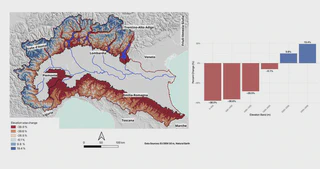Three decades of snow water equivalent dynamics in the Po River Basin, Italy: Trends and Implications

Abstract
Seasonal snowpack is a key component of the mountain cryosphere, acting as a vital natural reservoir that regulates runoff downstream in snowfed basins. In mid- and low-elevation mountain regions such as the European Alps, snow processes, such as accumulation and ablation, are highly sensitive to climate change, having direct implications for hydrological forecasting and water availability. In this study, we present the analysis of a 30-year (1991–2021) long dataset of snow water equivalent (SWE) in the Po River District, Italy, which includes parts of the Alps and Apennines. The data is available at a 500x500 m2 spatial resolution and at a daily temporal scale (Dall’Amico et al., 2025). This data was generated using the “J-Snow” modeling framework, which integrates the physically based GEOtop model with in situ snow height observations and earth observation snow cover products such as MODIS. Our results show that the long-term (30 year) basin-wide mean annual SWE volume equals 3.34 Gm3. The elevation-wise statistical analysis of key snow volume and duration metrics shows that the most pronounced snow water equivalent losses occur below 2000 m a.s.l. Below this threshold, both snow volume metrics and duration metrics show a significant decrease, indicating decrease in snow water storage and earlier melt. Above this elevation, the snow volume metrics show increasing trend while as the duration metrics continue to show a shortened (decreasing trend) snow season except at the highest elevations (>2500 m). The findings of this study highlight the changes to the mountain seasonal snow storage and the timing of snow dissappearance across the Italian Alps. This combined effect highlights a fundamental shift in the hydrological regime of the Po River Basin, with significant implications for water availability and management under ongoing climate change.
This work is based on the analysis on our previous paper on SWE data.